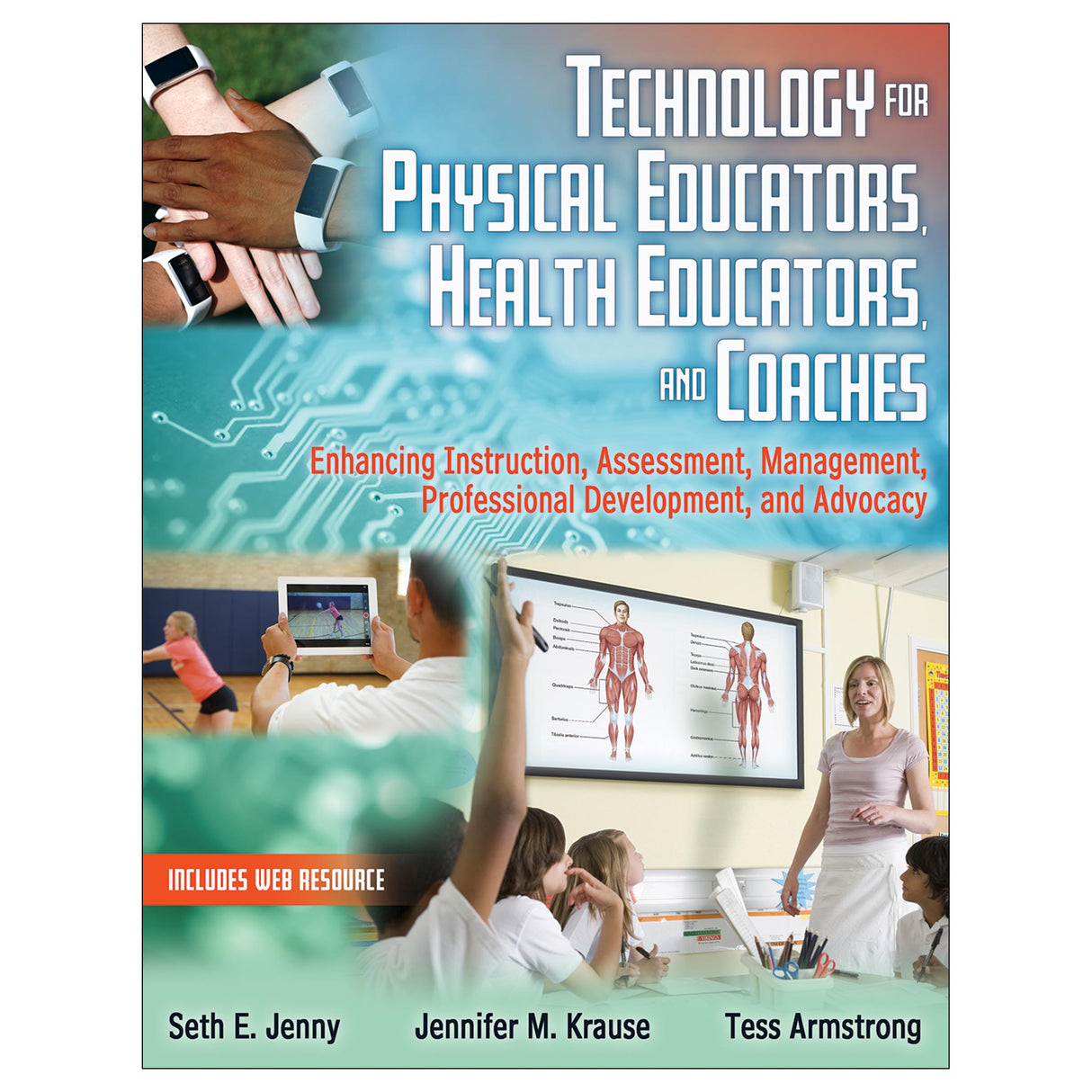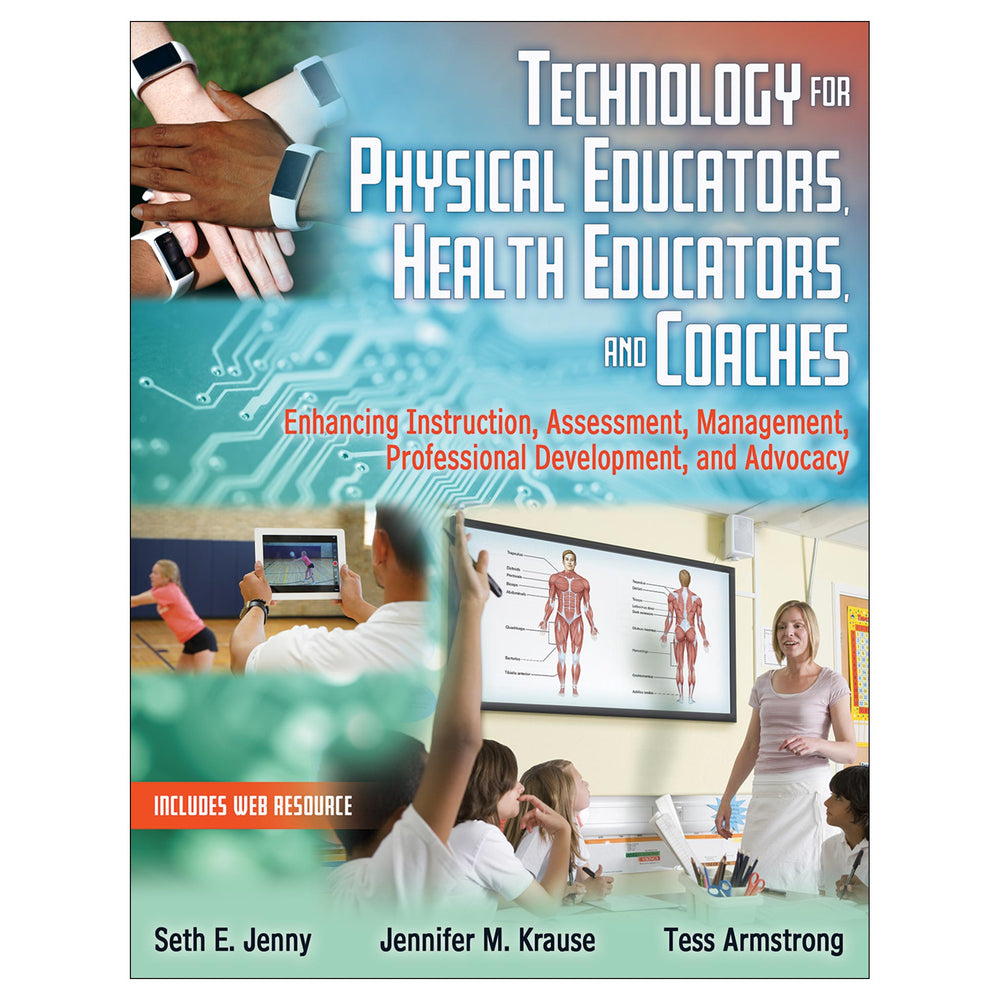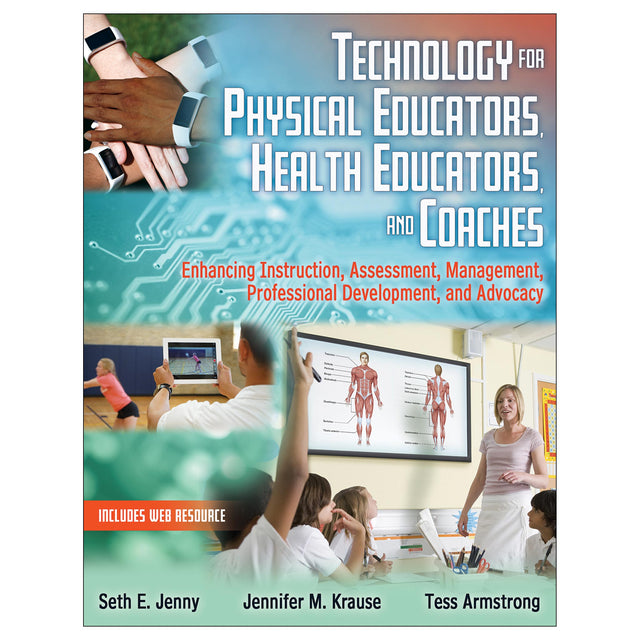Paperback With Online Resource
Technology for Physical Educators, Health Educators, and Coaches With Web Resource
Enhancing Instruction, Assessment, Management, Professional Development, and Advocacy
$86.00 USD
Unit price
/
Unavailable
Paperback With Online Resource
$86.00 USD
$86.00 USD
Paperback With Online Resource
A wide variety of technology is available to physical educators, health teachers, and coaches—but technology is only helpful if people know how to use it effectively.
This text will help health and physical education teachers and coaches improve their abilities by learning to effectively use technology in the areas of instruction, assessment, management, communication, professional development, and advocacy. The effective use of technology as outlined in this book can improve student and athlete performance and assessment and motivate active and healthy lifestyles among students.
An important distinction with this book is that it goes beyond simply discussing the technology tools—it helps readers understand how to use technology to improve instruction. Practical examples of how to use various technological tools are included for different settings and a variety of age groups (child to adult). Readers will learn about the effective use of technology in physical education, health education, and coaching.
Technology for Physical Educators, Health Educators, and Coaches is a practical, hands-on text that offers a number of useful tools:
The text is organized into six parts. Part I focuses on how technology can assist in meeting specific goals, objectives, and national standards within physical education, health education, and sport coaching. Part II covers technology for class and team management as well as communication technology, while part III explores how to leverage technology to facilitate teaching and learning, including within a traditional classroom, online, and with special populations. The authors address how to use technology for assessment in part IV, and part V delves into how technology can benefit professional development and advocacy. In part VI, the authors detail the all-important legal and financial aspects of technology.
This text will help health and physical education teachers and coaches improve their abilities by learning to effectively use technology in the areas of instruction, assessment, management, communication, professional development, and advocacy. The effective use of technology as outlined in this book can improve student and athlete performance and assessment and motivate active and healthy lifestyles among students.
An important distinction with this book is that it goes beyond simply discussing the technology tools—it helps readers understand how to use technology to improve instruction. Practical examples of how to use various technological tools are included for different settings and a variety of age groups (child to adult). Readers will learn about the effective use of technology in physical education, health education, and coaching.
Technology for Physical Educators, Health Educators, and Coaches is a practical, hands-on text that offers a number of useful tools:
- What Does the Research Say? sidebars that provide evidence for which technologies do and do not work in physical education, health education, and sport coaching, with accompanying explanations
- Tips, examples, and interviews from seasoned professionals on various types of technology
- Chapter objectives, key terms, review questions, and open-ended discussion questions, which could prove useful for online discussion boards
- Instructor ancillaries, including PowerPoint presentations and learning management system (LMS)–ready quizzes for each chapter, that help instructors organize, plan, teach, and assess content effectively
- Online web resource that offers a variety of tools, including additional practitioner interviews; links to websites, videos, and podcasts; sample handouts, and other activities and resources from practicing professionals. The online web resource will be updated annually to keep current with the changing technology.
- Social media accounts (@Tech4HPECoach) on Twitter and Facebook allow readers to further connect and share ideas. Use the hashtag #Tech4HPECoach across various social media platforms too!
The text is organized into six parts. Part I focuses on how technology can assist in meeting specific goals, objectives, and national standards within physical education, health education, and sport coaching. Part II covers technology for class and team management as well as communication technology, while part III explores how to leverage technology to facilitate teaching and learning, including within a traditional classroom, online, and with special populations. The authors address how to use technology for assessment in part IV, and part V delves into how technology can benefit professional development and advocacy. In part VI, the authors detail the all-important legal and financial aspects of technology.
Audience
Textbook for college courses on using technology in physical education, health education, and sport coaching. Professional reference for practicing teachers and coaches. Part I. Introduction to Technology in Physical Education, Health Education, and Coaching
Chapter 1. Introduction
Part II. Technology for Class and Team Management and Communication
Chapter 2. Management Technology
Chapter 3. Communication Technology
Part III. Technology for Instruction
Chapter 4. Technology for Health Education Classroom Instruction
Chapter 5. Technology for Motivation
Chapter 6. Technology for Lifelong Health and Fitness
Chapter 7. Meeting Special Needs and Abilities Through Technology
Chapter 8. Online Instruction and Remote Supervision
Part IV. Technology for Assessment
Chapter 9. Wearable Technology for Assessment
Chapter 10. Other Forms of Technology for Assessment
Chapter 11. Basic Digital Video Recording and Editing
Part V. Technology for Professional Development and Advocacy
Chapter 12. Technology for Professional Development
Chapter 13. Technology for Advocacy
Chapter 14. Technology Resources
Part VI. Legal and Financial Aspects of Technology
Chapter 15. Legal Aspects of Technology Use
Chapter 16. Technology Opportunities and Ideas for Acquiring Funding
Chapter 1. Introduction
Part II. Technology for Class and Team Management and Communication
Chapter 2. Management Technology
Chapter 3. Communication Technology
Part III. Technology for Instruction
Chapter 4. Technology for Health Education Classroom Instruction
Chapter 5. Technology for Motivation
Chapter 6. Technology for Lifelong Health and Fitness
Chapter 7. Meeting Special Needs and Abilities Through Technology
Chapter 8. Online Instruction and Remote Supervision
Part IV. Technology for Assessment
Chapter 9. Wearable Technology for Assessment
Chapter 10. Other Forms of Technology for Assessment
Chapter 11. Basic Digital Video Recording and Editing
Part V. Technology for Professional Development and Advocacy
Chapter 12. Technology for Professional Development
Chapter 13. Technology for Advocacy
Chapter 14. Technology Resources
Part VI. Legal and Financial Aspects of Technology
Chapter 15. Legal Aspects of Technology Use
Chapter 16. Technology Opportunities and Ideas for Acquiring Funding
“If you can learn about and implement one third of the resources mentioned in this text, you will be way ahead of the average teacher. You will set yourself apart and stand out as a knowledgeable educator who knows how to motivate and engage students, and you will increase your productivity and effectiveness at your job.”
—Ben Landers, NBCT, Elementary Physical Education Teacher and Founder of The PE Specialist
“At last a book has been written that guides educators toward the best, most effective way to incorporate technology into all aspects of their professional life. While a teacher’s tech tool of choice will change over time, best practices will remain a constant, and this is the book to empower all teachers.”
—Andrew Milne, 2017 SHAPE America Health Education Teacher of the Year and Creator of the SlowChatHealth Blog
“Some coaches may be hesitant to add new technology to their coaching practice, but this book eases that fear. I highly recommend this textbook to coaches and coach educators.”
—Dr. Scott Douglas, Board Member for the United States Center for Coaching Excellence (USCCE) and Sport Coaching Program Coordinator at the University of Northern Colorado
“This is a text that embraces the current professional expectations of health educators, physical educators, and coaches within a 21st century classroom.”
—Collin Brooks, PhD Candidate, Former Elementary Physical Education Teacher, and Cocreator of PhysEdagogy
“The chapter Meeting Special Needs and Abilities Through Technology provides an excellent overview of a wide range of assistive technologies and guides the reader on how to incorporate specific equipment, devices, and apps in order to help students with disabilities engage with the health and physical education curriculum in a meaningful way.”
—Dr. Scott McNamara, CAPE, Professor of Adapted Physical Education at the University of Northern Iowa
“More than a how-to manual, the text presents a student-centered model for engaging the current generation of digital natives in exciting ways. It is an excellent resource for today’s educators and coaches committed to healthy lifestyles.”
—Dr. Joanne Leight, Chair of the Department of Health and Physical Education at Slippery Rock University and Author of Technology for Fitness and Wellness Professionals
—Ben Landers, NBCT, Elementary Physical Education Teacher and Founder of The PE Specialist
“At last a book has been written that guides educators toward the best, most effective way to incorporate technology into all aspects of their professional life. While a teacher’s tech tool of choice will change over time, best practices will remain a constant, and this is the book to empower all teachers.”
—Andrew Milne, 2017 SHAPE America Health Education Teacher of the Year and Creator of the SlowChatHealth Blog
“Some coaches may be hesitant to add new technology to their coaching practice, but this book eases that fear. I highly recommend this textbook to coaches and coach educators.”
—Dr. Scott Douglas, Board Member for the United States Center for Coaching Excellence (USCCE) and Sport Coaching Program Coordinator at the University of Northern Colorado
“This is a text that embraces the current professional expectations of health educators, physical educators, and coaches within a 21st century classroom.”
—Collin Brooks, PhD Candidate, Former Elementary Physical Education Teacher, and Cocreator of PhysEdagogy
“The chapter Meeting Special Needs and Abilities Through Technology provides an excellent overview of a wide range of assistive technologies and guides the reader on how to incorporate specific equipment, devices, and apps in order to help students with disabilities engage with the health and physical education curriculum in a meaningful way.”
—Dr. Scott McNamara, CAPE, Professor of Adapted Physical Education at the University of Northern Iowa
“More than a how-to manual, the text presents a student-centered model for engaging the current generation of digital natives in exciting ways. It is an excellent resource for today’s educators and coaches committed to healthy lifestyles.”
—Dr. Joanne Leight, Chair of the Department of Health and Physical Education at Slippery Rock University and Author of Technology for Fitness and Wellness Professionals
Lifetime Health Technologies: Sample high school Wearable Activity Tracker Assignment
Opportunities and Ideas for Acquiring Technology: School-Based Funding
Technology for Motivation
Technology in Coaching
Using digital Technology in Adapted PE




Opportunities and Ideas for Acquiring Technology: School-Based Funding
Technology for Motivation
Technology in Coaching
Using digital Technology in Adapted PE




All ancillaries are free to adopting instructors and available online.
Instructor guide. Includes chapter-by-chapter learning objectives, review questions, open-ended discussion questions (ideal for online course discussions), and a plethora of assignment ideas. A sample course syllabus, course pacing and format suggestions, and more general assessment ideas are also included.
Test package. Features 225 learning management system (LMS)–ready multiple-choice and true-false questions, divided by chapter.
Presentation package. Includes more than 250 PowerPoint slides of text and key illustrations that cover each chapter of the book. Instructors can easily add, modify, and rearrange the order of the slides.
Web resource. Features a variety of tools, including additional practitioner interviews; links to websites, videos, and podcasts; sample handouts and assignments; and other activities and resources from practicing professionals that correspond to and augment each chapter. The web resource will be updated annually to keep current with changing technology.
Instructor guide. Includes chapter-by-chapter learning objectives, review questions, open-ended discussion questions (ideal for online course discussions), and a plethora of assignment ideas. A sample course syllabus, course pacing and format suggestions, and more general assessment ideas are also included.
Test package. Features 225 learning management system (LMS)–ready multiple-choice and true-false questions, divided by chapter.
Presentation package. Includes more than 250 PowerPoint slides of text and key illustrations that cover each chapter of the book. Instructors can easily add, modify, and rearrange the order of the slides.
Web resource. Features a variety of tools, including additional practitioner interviews; links to websites, videos, and podcasts; sample handouts and assignments; and other activities and resources from practicing professionals that correspond to and augment each chapter. The web resource will be updated annually to keep current with changing technology.





